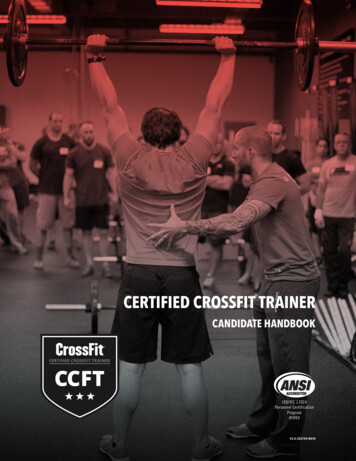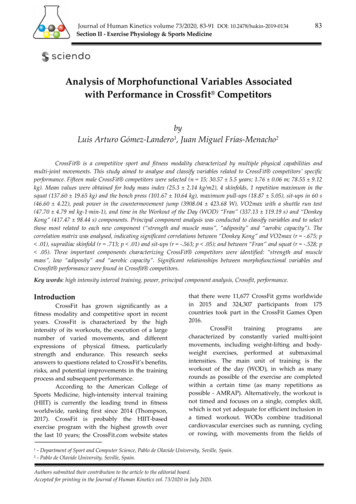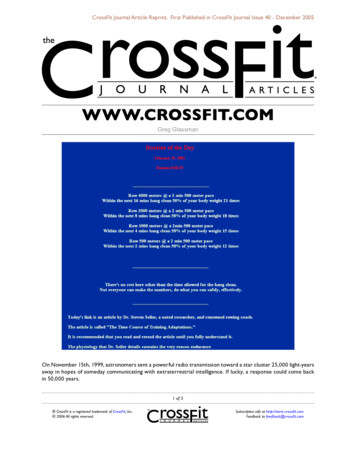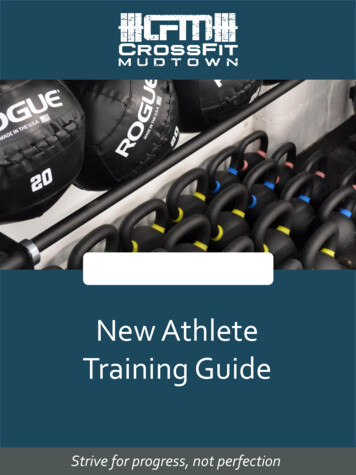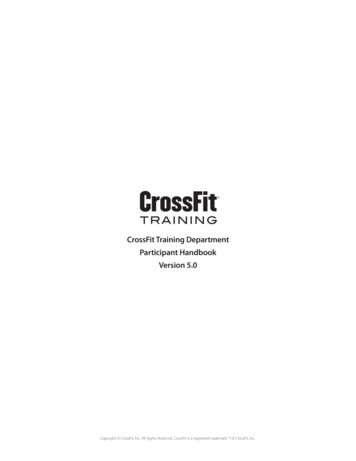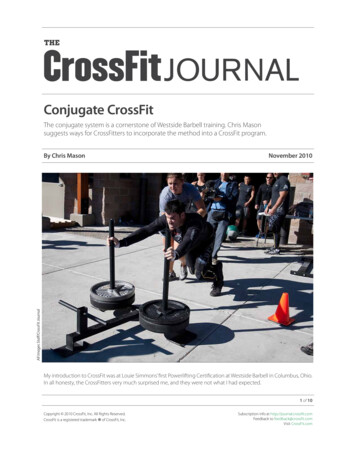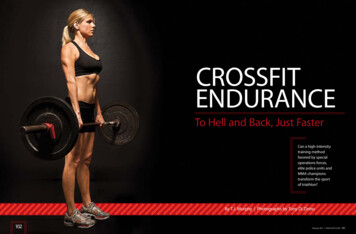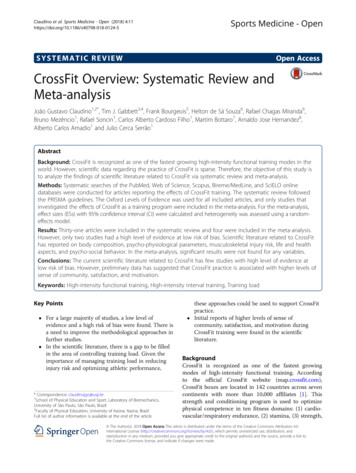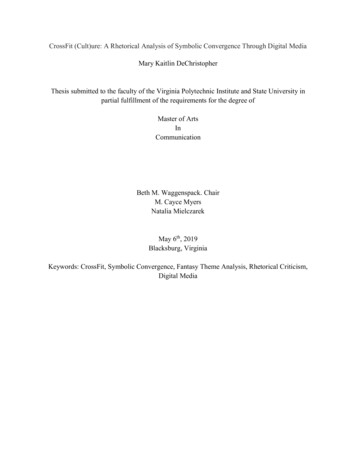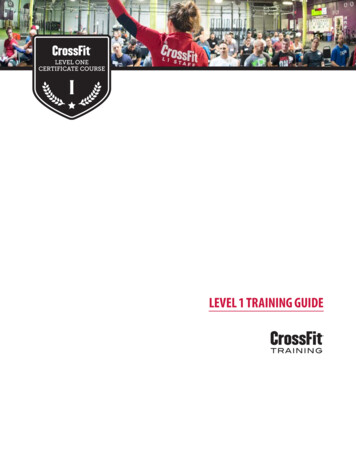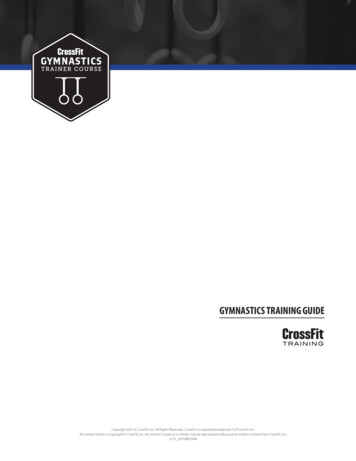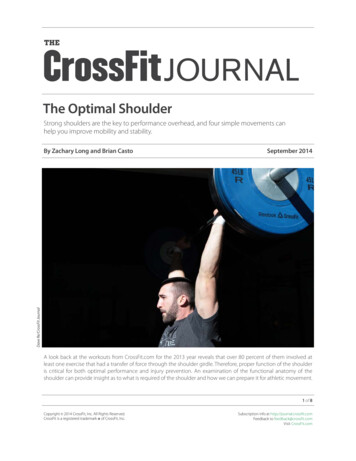
Transcription
THEJOURNALThe Optimal ShoulderStrong shoulders are the key to performance overhead, and four simple movements canhelp you improve mobility and stability.September 2014Dave Re/CrossFit JournalBy Zachary Long and Brian CastoA look back at the workouts from CrossFit.com for the 2013 year reveals that over 80 percent of them involved atleast one exercise that had a transfer of force through the shoulder girdle. Therefore, proper function of the shoulderis critical for both optimal performance and injury prevention. An examination of the functional anatomy of theshoulder can provide insight as to what is required of the shoulder and how we can prepare it for athletic movement.1 of 8Copyright 2014 CrossFit, Inc. All Rights Reserved.CrossFit is a registered trademark of CrossFit, Inc. Subscription info at http://journal.crossfit.comFeedback to feedback@crossfit.comVisit CrossFit.com
Optimal Shoulder .(continued)Functional Anatomy of the Shoulder ComplexThe shoulder, or glenohumeral joint, is a ball-and-socketjoint. The socket of the scapula is known as the glenoid.Unlike the hip socket, which is quite deep, the glenoidis relatively flat and not large. The shoulder joint is oftencompared to a golf ball on a tee to illustrate that themajority of the glenohumeral joint’s stability does notcome from boney approximation. Instead, four musclescollectively referred to as the rotator cuff provide dynamicstability to the glenohumeral joint.The supraspinatus sits on the top of the shoulder joint,and it keeps the humerus pulled close to the glenoid,contributes to the external rotation of the joint andabducts the shoulder. The infraspinatus and teres minormake up the posterior rotator cuff and provide themajority of external-rotation torque to the shoulder. Theyalso exert an inferior pull on the shoulder during elevation.This pull prevents the humeral head from sliding upwarddue to the pull from the deltoid muscles, which wouldresult in impingement of the structures between thehumeral head and acromion. The subscapularis originateson the front side of the scapula and both compresses andinternally rotates the glenohumeral joint (8). The deltoidsare superficial to the rotator-cuff muscles and work to flex,abduct, extend and rotate the shoulder.exercises—such as thrusters and jerks—in which the legsprovide large amounts of force that is then transferredthrough the body to the shoulders and arms to completethe movement.Another important role of thescapula is to transfer forces fromthe legs and trunk to the upperextremities.Imbalances of the Shoulder ComplexShoulder imbalances can decrease an athlete’s performance and increase risk of injury. Imbalances can placeunnecessary levels of stress on tissues; therefore, it isAnother important role of the scapula is to transfer forcesfrom the legs and trunk to the upper extremities. Forexample, studies on the tennis serve show that over 50percent of the total kinetic energy and force is generatedin the trunk and lower extremities. These forces arethen transferred through the scapula to the arm (4).This is also seen in a variety of frequently used CrossFitAlicia Anthony/CrossFit JournalMovement and stability of the scapula are equallyimportant to shoulder function. Proper scapulamovement is important for providing a stable base forthe glenohumeral joint. When raising the arm overhead,shoulder elevation comes from both the humerusmoving on the glenoid and the scapula rotating upward.The scapula should move approximately 1 degree forevery 2 degrees of humeral movement. This upwardrotation of the scapula comes from a balance of muscleactivity between the upper trapezius, lower trapeziusand serratus anterior muscles. Proper functioning ofthese muscles is important for lifts such as overheadpresses. Other exercises, such as rowing, and properposture rely on strength in the rhomboids and traps,which produce scapular retraction (8).In a push press, the scapulae transfer force generated by the lowerbody to the shoulders and arms.2 of 8Copyright 2014 CrossFit, Inc. All Rights Reserved.CrossFit is a registered trademark of CrossFit, Inc. Subscription info at http://journal.crossfit.comFeedback to feedback@crossfit.comVisit CrossFit.com
Optimal Shoulder .(continued)vital that an athlete maintain a stable muscular basearound the shoulder while also maintaining adequatemobility in order to decrease the risk of injury. Theneed to address both mobility and stability cannot beemphasized enough.phasic are prone to weakness or inhibition (7). With a predisposition to weakness in our phasic muscles, it is of utmostimportance to maintain proper strength in these muscleswhile maintaining proper length in the tonic muscles.Table 1In order to understand how to prevent or reverse muscleimbalances, we must first understand why they are socommon among athletes and members of the generalpublic. Functionally, muscles have been classified as “tonic”and “phasic.”The tonic muscles are prone to tightness, and theAlicia Anthony/CrossFit JournalMobility issues should be addressed before stability. Butafter gains in mobility, stability work should follow. Ifmobility is not improved, stability problems should beexamined. Oftentimes, lack of mobility can actually bethe result of a stability problem as the body decreasesmobility in an attempt to create artificial stability (2).An easy example can be seen in a standing hamstringstretch. An athlete’s mobility in this movement canoften be improved by having him or her squeeze a ballbetween the knees. This squeeze increases core activity(stabilization) and often allows the person to reach farther.70 Tonic MusclesPhasic MusclesPectoralis majorSerratus anteriorUpper trapeziusRhomboidsLevator scapulaeLower trapeziusScalenesDeep neck flexorsSternocleidomastoidUpper-limb extensorsUpper-limb flexors85 A functional shoulder is characterized by both strength and mobility. Both must be maintained for optimal performance.3 of 8Copyright 2014 CrossFit, Inc. All Rights Reserved.CrossFit is a registered trademark of CrossFit, Inc. Subscription info at http://journal.crossfit.comFeedback to feedback@crossfit.comVisit CrossFit.com
Optimal Shoulder .(continued)As previously discussed, proper scapula movement andstability during overhead activities occur as a result ofthe coordinated activity of the upper trapezius, lowertrapezius and serratus anterior. Numerous studieshave suggested altered scapular rotation and higheractivity in the upper trapezius compared to the lowertrapezius and serratus anterior are commonly seen inmultiple shoulder pathologies (3,4,5). This imbalancefalls in line with patterns of tonic vs. phasic muscles.Clinically, retraining muscle activity and properscapular movement can be troublesome, and exercisesthat provide little opportunity for compensation arebest suited to the task.From a standpoint of pure sports performance, musclescannot develop maximum levels of torque absent astable base, leading to decreased strength. Calculationsperformed by Kibler found that as little as a 20 percentdecrease in energy delivered by the hip and trunk resultsin a need for 80 percent more mass or 34 percent morerotational velocity in the shoulder joint to produce thesame levels of force through the upper extremities. Thishuge increase in shoulder workload due to an unstablebase will not only decrease the efficiency of the entiresystem during a movement such as a push press but willalso likely overload the shoulders, potentially leading tooveruse injuries (4).Strengthening the rotator cuff itselfwill help keep the humeral headproperly positioned on the scapuladuring shoulder movements.Increasing activation of the phasic muscles will create amore stable base for the entire shoulder complex. This willhelp decrease strain on the multitude of structures withinthe shoulder, such as the rotator cuff. Strengthening therotator cuff itself will help keep the humeral head properlypositioned on the scapula during shoulder movements.Exercises for Improving Shoulder BalanceThe following are exercises we believe to be excellenttools for both decreasing injury risk and addressingcommon imbalances in the shoulder complex thatprevent maximum movement efficiency during highintensity exercise.Dave Re/CrossFit JournalDave Re/CrossFit JournalOne area of imbalance that is common in athletes is anoverworked or fatigued rotator cuff. In a study performedby Chopp et al., it was found that continuous overheadwork accelerates rotator-cuff fatigue. If the rotator cuffis fatigued, the humeral head may migrate superiorly,narrowing the subacromial space, thus putting theathlete at greater risk for subacromial impingement (1).With continuous overhead motion, a strong rotator cuffis a key element in preventing injury or decreasing thelikelihood of injury.On the left, the athlete has locked out the elbows with little protraction of the shoulders. On the right, she has been cued to “push the spinetoward the ceiling,” resulting in shoulder protraction and greater activation of the serratus anterior and subscapularis.4 of 8Copyright 2014 CrossFit, Inc. All Rights Reserved.CrossFit is a registered trademark of CrossFit, Inc. Subscription info at http://journal.crossfit.comFeedback to feedback@crossfit.comVisit CrossFit.com
Optimal Shoulder .(continued)Push-UpsFortunately for CrossFit athletes, one of the best exercisesfor strengthening the serratus anterior is commonlyperformed in CrossFit workouts. The push-up hasbeen shown to significantly activate this muscle (9).Performance of a push-up with “a plus” will further activateboth the serratus anterior and the subscapularis muscle.A normal push-up generally focuses on elbow lockout,and the plus portion can be added by protracting theshoulders—sliding the scapulae forward on the rib cageat the top of the rep (8). The push-up with a plus (or simplythe plus portion of the movement) can be performed byitself as part of a pre-hab program, as performance of theentire push-up-with-a-plus movement during a workoutwould greatly reduce speed.Bilateral External Rotations, aka Shoulder W’sFace Pull Y PressThe face pull Y press (FPYP) is great for injury preventionand performance as well. Begin with your arms straight infront of you while holding onto a resistance band (ringsor a cable column work as well). Next, pull your armsback so your elbows are at shoulder height and yourforearms remain parallel to the ground. Externally rotateyour shoulders, positioning the forearms at vertical withyour elbows remaining level with the shoulders. Pushyour arms up, creating a Y with the arms overhead beforereturning to the starting position. To perform the FPYPwith rings, assume the same starting position as usedwith ring rows, but use a stance that places the torso ina more vertical position. Then perform the same shouldermovements described above.The FPYP is effective because it works the externalrotators of the shoulder while also stressing the phasicscapular muscles (see Table 1), such as the rhomboids,lower traps and serratus anterior. Both of these musclegroups are important for injury prevention becausethey help maintain proper scapula positioning whilestrengthening the rotator cuff. Most importantly, the topof the FPYP resembles the position seen in many of theoverhead lifts performed in CrossFit. Strengthening thestabilizing muscles in this position will translate to betterperformance in press variations and exercises such asthe snatch. Perform 2-3 sets of 10-plus repetitions withDave Re/CrossFit JournalDave Re/CrossFit JournalOne highly effective injury-prevention and rehab exerciseis the bilateral external rotator, or shoulder W. This exerciseis performed by holding a resistance band with the elbowsagainst the sides, the forearms directed in front and thepalms facing up. Once you are set up properly, externallyrotate your shoulders by moving your hands apart whilekeeping the elbows near the body. This external rotation iscoupled with scapular retraction by pulling the shoulderblades toward each other. The shoulder W is effectivebecause it provides good activation of the lower trapeziuswith lower levels of upper-trap activation. A goodratio of lower-trap-to-upper-trap activation makes thismovement a great choice for those who are upper-trapdominant, and it has the added benefit of strengtheningthe posterior rotator cuff due to the external rotationof the shoulder (6). For the shoulder W, we recommend20-30 reps performed as part of your warm-up.The shoulder W combines external rotation with scapular retraction, activating the lower trapezius and strengthening the rotator cuff.5 of 8Copyright 2014 CrossFit, Inc. All Rights Reserved.CrossFit is a registered trademark of CrossFit, Inc. Subscription info at http://journal.crossfit.comFeedback to feedback@crossfit.comVisit CrossFit.com
Optimal Shoulder .(continued)a steady tempo. For those really working on overheadstability, pause at the top of the Y for a moment beforereturning to the starting position.Reach, Roll and LiftThis exercise is excellent because it challenges bothmobility and stability in the overhead position with littlechance of compensations from other muscles or joints.The reach, roll and lift will also facilitate activation of thelower traps and serratus muscles.This exercise is deceivingly difficult and can frequentlyexpose limitations in mobility of the shoulder complexand weaknesses in the strongest athletes. Perform 2 setsof 10 reps, keeping the elbow as straight as possible andensuring the shoulder blade is depressed prior to lifting.Most athletes are unable to maintain full elbow extensioninitially. Make progress in this exercise by increasing elbowextension and then increasing repetitions. An athlete withgood mobility and stability of the shoulder complex canperform 20-plus perfect reps.Dave Re/CrossFit JournalDave Re/CrossFit JournalDave Re/CrossFit JournalDave Re/CrossFit JournalBegin in a quadruped position (on all fours) and rock backuntil your heels meet your butt. Make a fist with one handand place your forehead on top of it. Put your oppositearm in front of you and reach forward as far as possiblewhile relaxing the other side of the body. Reach forward,roll your thumb up toward the ceiling, depress theshoulder blade by pulling it downward and lift the arm. Besure to keep the elbow as straight as possible throughoutthe movement.The face pull Y press works the external rotators and also targets phasic muscles such as the rhomboids and serratus anterior.Note how the final position resembles the overhead position seen in many lifts.6 of 8Copyright 2014 CrossFit, Inc. All Rights Reserved.CrossFit is a registered trademark of CrossFit, Inc. Subscription info at http://journal.crossfit.comFeedback to feedback@crossfit.comVisit CrossFit.com
(continued)Dave Re/CrossFit JournalDave Re/CrossFit JournalDave Re/CrossFit JournalDave Re/CrossFit JournalOptimal Shoulder .In the reach, roll and lift, movement should occur only at the shoulder joint. The set-up position is designed to eliminate compensatorymovement patterns such as arching the back. Many athletes will find this exercise exceptionally difficult.This exercise makes a great follow-up to mobility workas well. For example, take an athlete with slightly limitedshoulder flexion who stretches and gains full motion.After gaining this motion, it is important to challenge thestability in the newly available range to help maintainthese gains (2). While a shoulder press may be a goodoption for this purpose, it still provides multiple levelsof potential compensatory patterns such as an excessively arched back. The reach, roll and lift may be a betterfollow-up for many as it provides less opportunity forcompensation and is therefore better in helping maintainthis improved motion.Mobility and StabilityThe shoulder is a complex anatomical structure, andproper mobility and stability must be in place for the jointto perform most efficiently and without increased risk ofinjury. Rehab and pre-hab work is highly recommendedfor any athlete looking to improve or maintain shoulderhealth and function.FReferences1. Chopp JN, O’Neill JM, Hurley K, and Dickerson CR.Superior humeral head migration occurs after a protocoldesigned to fatigue the rotator cuff: A radiographicanalysis. Journal of Shoulder and Elbow Surgery 19:1137-1144, 2010.7 of 8Copyright 2014 CrossFit, Inc. All Rights Reserved.CrossFit is a registered trademark of CrossFit, Inc. Subscription info at http://journal.crossfit.comFeedback to feedback@crossfit.comVisit CrossFit.com
Optimal Shoulder .(continued)2. Cook G, Burton L, Kiesel K, Rose G, and Bryant MF.Movement: Functional Movement Systems: Screening,Assessment and Corrective Strategies. Santa Cruz, Calif.: OnTarget Publications, 2010. p. 408.3. Cools AM, Witvrouw EE, Declercq GA, Danneels LA,and Cambier DC. Scapular muscle recruitment patterns:Trapezius muscle latency with and without impingementsymptoms. The American Journal or Sports Medicine 31(4):542-549, 2003.conferences. He currently runs ActivePTblog.com and works atThe Physical Therapy Center in Waxhaw, North Carolina.Brian Casto received his bachelor’s degree in exercise sciencefrom Fairmont State University and then his doctorate inphysical therapy from Wheeling Jesuit University. Casto playedfour years of college football, coached football at the highschool level and has taken USAW’s National WeightliftingCoach course. He works at The Physical Therapy Center inMonroe, North Carolina.4. Kibler WB. The role of the scapula in athletic shoulderfunction. The American Journal of Sports Medicine 26(2):325-327, 1998.5. Ludewig P and Reynold J. The association of scapularkinematics and glenohumeral joint pathologies. Journal ofOrthopedic and Sports Physical Therapy 39(2): 2009.6. McCabe R, Orishimo K, McHugh M, and Nicholas S.Surface electromyographic analysis of the lower trapeziusmuscle during exercises performed below ninety degreesof shoulder elevation in healthy subjects. Journal of SportsPhysical Therapy 2(1): 34-43, 2007.7. Page P and Frank C. The Janda approach to chronicmusculoskeletal pain. Thera-Band Academy. leta-Pain 011606 151616.pdf. Accessed Sept. 18, 2014.8. Reinold M, Escamilla R, and Wilk K. Current concepts inthe scientific and clinical rationale behind exercises forglenohumeral and scapulothoracic musculature. Journalof Orthopaedic & Sports Physical Therapy 39(2): 105-117,2009.9. Youdas JW, Budach BD, Ellerbusch JV, Stucky CM, WaitKR, and Hollman JH. Comparison of muscle-activationpatterns during the conventional push-up and perfectpushup exercises. Journal of Strength and ConditioningResearch 24(12): 3352-3362, 2010.About the AuthorsZach Long is a physical therapist and strength-and-conditioning coach in Waxhaw, North Carolina. He attended theUniversity of North Carolina at Chapel Hill, where he majoredin exercise and sport science, and East Carolina University,where he received his doctorate in physical therapy. Long’sresearch related to physical therapy and athletic rehabilitation has been presented at multiple state and national8 of 8Copyright 2014 CrossFit, Inc. All Rights Reserved.CrossFit is a registered trademark of CrossFit, Inc. Subscription info at http://journal.crossfit.comFeedback to feedback@crossfit.comVisit CrossFit.com
entire push-up-with-a-plus movement during a workout would greatly reduce speed. Bilateral External Rotations, aka Shoulder W's One highly effective injury-prevention and rehab exercise is the bilateral external rotator, or shoulder W. This exercise is performed by holding a resistance band with the elbows
